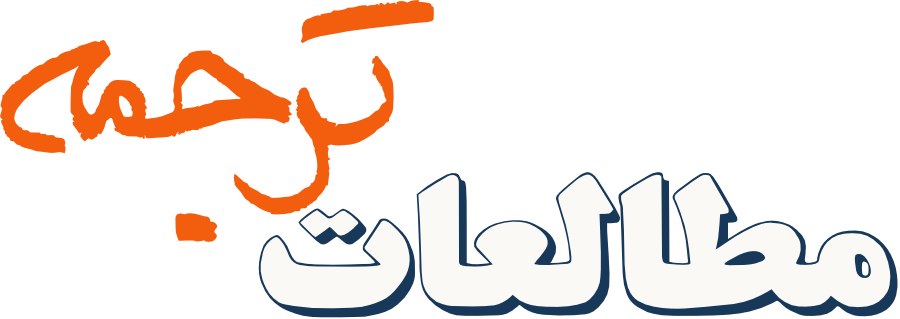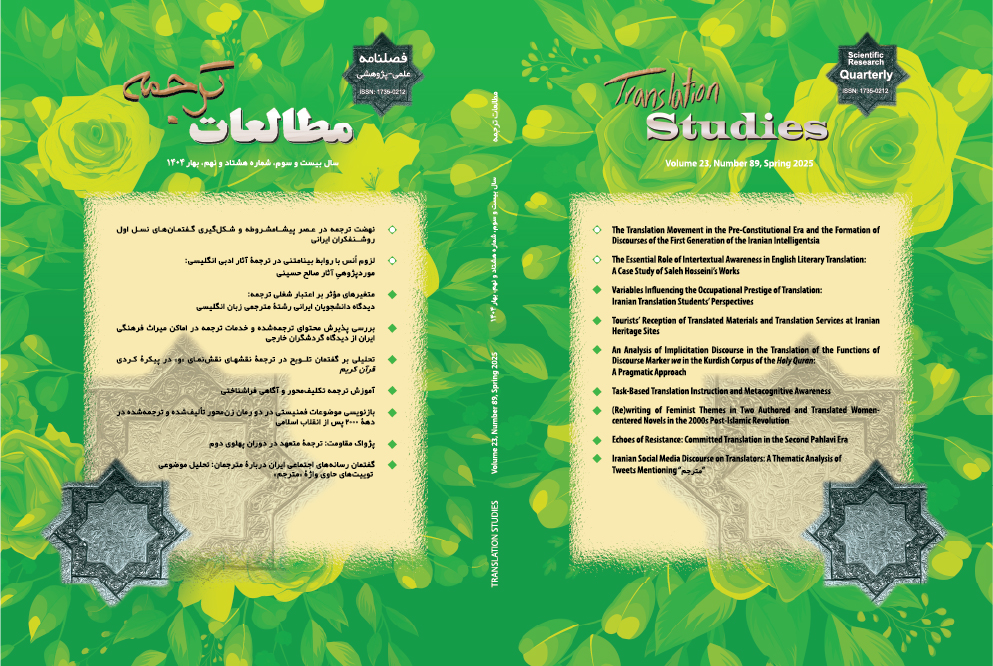بررسی پذیرش محتوای ترجمهشده و خدمات ترجمه در اماکن میراث فرهنگی ایران از دیدگاه گردشگران خارجی
مطالعۀ موردی وبگاه تریپادوایزر
چکیده
اماکن میراث فرهنگی، بهمثابۀ گنجینههایی تاریخی، اهمیت فراوانی دارند و آثار باستانی را بهعنوان بازتابی از سنتهای بشری حفظ میکنند. این جاذبهها، با استقبال از بازدیدکنندگان داخلی و خارجی، نقشی اساسی در توسعۀ صنعت گردشگری ایفا می کنند و نیازمند ارائه خدمات باکیفیت هستند. در میان این خدمات، ترجمه جایگاه ویژهای در تسهیل ارتباطات و بهبود تجربۀ گردشگران خارجی دارد. پژوهش حاضر با تحلیل نظرات برخط گردشگران، مطالب ترجمهشده و خدمات ترجمه در اماکن میراث فرهنگی ایران را بررسی می کند. به منظور ارزیابی پاسخهای گردشگران، چارچوب «پذیرش ترجمه» چسترمن به کار گرفته شد. دادههای این پژوهش شامل 522 نظر دربارۀ 45 مکان تاریخی در دوازده شهر توریستی ایران است که از وبگاه تریپادوایزر جمعآوری شدهاند. در مرحلۀ نخست تحلیل، چهار مضمون اصلی و ده مضمون فرعی مرتبط با ترجمۀ بینزبانی و ترجمۀ استعاری شناسایی شد. تمامی نظرات بر اساس این مضامین دستهبندی شدند. نتایج نشان داد که وجود مطالب ترجمهشده در این اماکن تاریخی، برجستهترین موضوع مورد بحث بوده و این مسئله بیانگر آن است که نیاز گردشگران به بهرهگیری از محتوای ترجمهشده ممکن است اهمیت بیشتری نسبت به کیفیت ترجمه و نقش کارکنان و راهنمایان گردشگری در جایگاه مترجمان بینزبانی یا استعاری داشته باشد. بهطور کلی، 68٪ از نظرات مثبت و 32٪ منفی بودند. پژوهش حاضر با تحلیل بازخورد گردشگران، به شکافی در موضوع دریافت ترجمه توجه می کند و بینشهای ارزشمندی را برای بهبود دسترسی و خدمات ترجمه در اماکن میراث فرهنگی ارائه میدهد. این یافتهها میتواند برای کارکنان و مترجمان حوزۀ گردشگری مفید واقع شود.
مراجع
Agorni, M. (2012). Tourism communication: The translator’s responsibility in the translation of cultural difference. Pasos. Revista de Turismo y Patrimonio Cultural, 10(4), 5–11.
Antonić, M. P. (2020). Reception of English Translations of Croatian Tourist Brochures: A pilot study. In A. Ketola, O. Paloposki, & T. Mikolič Južnič (Eds.), New Horizons in Translation Research and Education (Vol. 5, pp. 159–179).
Baker, M. (2006). Translation and conflict: A narrative account (1st ed.). Routledge.
Bolouri, M., & Jalali, J. (2023). Translated fiction in Iran: Readers’ reception and expectations. Journal of Language Horizons, 7(3), 209–234. https://doi.org/lghor.2023.40559.1695/
Catir, O. (2024). Determining the experience of museum visitors by text mining: Example of Topkapı Palace Museum. International Journal of Tourism Policy, 14(1), 107–118.
Chesterman, A. (2007). Bridge concepts in translation sociology. In A. Fukari & M. Wolf (Eds.), Constructing a sociology of translation (pp. 171–183). John Benjamins.
Eftekhar, E., Ferdowsi, S., & Azad, S. B. (2024). Exploring expectations of Iranian audiences in terms of consecutive interpreting: A reception study. Cadernos de Tradução, 44(1).
Garden, M.-C. E. (2009). The heritagescape: Looking at heritage sites. In M. L. S. Sørensen & J. Carman (Eds.), Heritage Studies (1st ed., pp. 288–309). Routledge.
Harrison, R. (2010). What is heritage. Understanding the Politics of Heritage, 9.
Li, Z., Shu, S., Shao, J., Booth, E., & Morrison, A. M. (2021). Innovative or not? The effects of consumer perceived value on purchase intentions for the palace museum’s cultural and creative products. Sustainability, 13(4), 2412.
Lin, W., & Zhang, X. (2024). A Study on the Translation Quality of Chuanzheng Cultural Tourism Texts from the Perspective of Reception Aesthetics. Journal of Humanities, Arts and Social Science, 8(11).
Manfredi, M., & Bartolini, C. (2023). Integrating Museum Studies into Translation Studies: Towards a reconceptualization of the source text as sensory experience in museum audio description and the notion of experiential equivalence. Translation Studies, 16(2), 261–276. https://doi.org/10.1080/14781700.2023.2208129/
Moreno-Mendoza, H., Santana-Talavera, A., & Molina-González, J. (2021). Formation of clusters in cultural heritage–strategies for optimizing resources in museums. Journal of Cultural Heritage Management and Sustainable Development, 11(4), 580–595.
Neather, R. (2020). Museums as translation zones. In E. Bielsa & D. Kapsaskis (Eds.), The Routledge Handbook of Translation and Globalization (pp. 306–319). Routledge.
Poria, Y., Reichel, A., & Biran, A. (2006). Heritage site perceptions and motivations to visit. Journal of Travel Research, 44(3), 318–326. https://doi.org/0047287505279004/
Riva, P., & Agostino, D. (2022). Latent dimensions of museum experience: Assessing cross-cultural perspectives of visitors from tripadvisor reviews. Museum Management and Curatorship, 37(6), 616–640. https://doi.org/10.1080/09647775.2022.2073560/
Rizzo, A. (2022). Into the translation for museums, festivals, and the stage: Creativity and the transmedial turn. Status Quaestionis, 23. https://doi.org/doi.org/10.13133/2239-1983/18213/
Salajegheh, S. (2024). A Comparative Study of the Effectiveness of Persian and English Labels in Tehran Museums [Unpublished master’s thesis]. Allameh Tabataba’i University.
Shafiei, F. S. (2025). A Thematic Analysis of Audience Responses to Subtitles in Youtube [Unpublished master’s thesis]. Allameh Tabataba’i University.
Sturge, K. (2014). Representing others: Translation, ethnography and museum. Routledge. https://doi.org/10.4324/9781315760421/
Sulaiman, M. Z. (2016). The misunderstood concept of translation in tourism promotion. Translation & Interpreting: The International Journal of Translation and Interpreting Research, 8(1), 53–68.
Sulaiman, M. Z., & Wilson, R. (2021). Tourism translation. In Y. Gambier & L. van Doorslaer (Eds.), Handbook of Translation Studies (pp. 213–220). John Benjamins Publishing Company.
Suojanen, T., Koskinen, K., & Tuominen, T. (2014). User-centered translation. Routledge.
Tan, Y., Qiao, X., & Ma, Y. (2021). A study on Chinese-English translation of international publicity of the northern Shaanxi tourism in China from the perspective of reception aesthetics. Open Journal of Modern Linguistics, 11(3), 415–423.
Trisno, R., Wibisono, A., Lianto, F., & Sularko, V. (2020). Translation of Narratology Model in Literature into Narrative Museum Architecture. The 2nd Tarumanagara International Conference on the Applications of Social Sciences and Humanities (TICASH 2020), 1141–1146. https://www.atlantis-press.com/proceedings/ticash-20/125948095/
Whitehead, C. (2011). Interpreting art in museums and galleries. Routledge.
Downloads
چاپشده
ارجاع به مقاله
شماره
نوع مقاله
DOR
مجوز
حق نشر 2025 Samin Salajegheh

این پروژه تحت مجوز بین المللی Creative Commons Attribution-NonCommercial 4.0 می باشد.
Copyright Licensee: Iranian Journal of Translation Studies. This article is an open access article distributed under the terms and conditions of the Creative Commons Attribution–NonCommercial 4.0 International (CC BY-NC 4.0 license).





